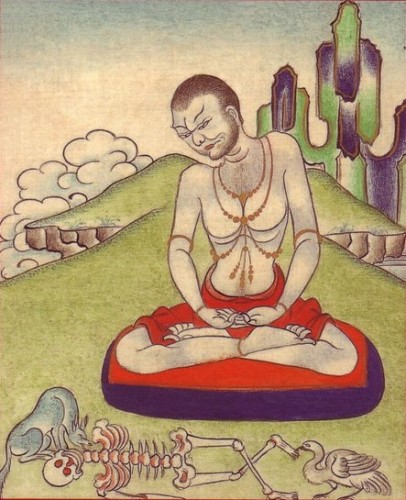The Siddha Kankaripa, The Lovelorn Widower
19 May
My Dakini-woman, my queen, my lady!
The visible form of my pure awareness,
Form not separate from me, nor yet a part of me,
The phenomenal appearance of empty space:
She is beyond compare and beyond words.
In Magadha there once lived a householder of low caste. He married a girl of his own social status and settled down. He was not an immoral man, but caring not a whit for the virtuous life that leads to spiritual freedom, after tasting the delights of connubial bliss he became obsessed with sensual pleasure. He experienced peaks of undreamed ecstasy. However, while he was still more than content with his lot, believing that this world alone could fulfill all his desires, his beloved wife came to her appointed time and died. He carried her corpse to the cremation ground, and there he broke down and lost himself in sorrow. His mind and will paralyzed, he was unable to tear himself away from his beloved’s corpse. It was in this state of despair that an enlightened yogin found him and asked him what was wrong.
“Can’t you see the state I’m in, yogin?” he cried. “The loss of my wife is the end of this glorious life for me. It’s as if I’ve just had my eyes torn out. No one on earth can suffer more than this.”
“All life ends in death; every meeting ends in parting; all compounded things eventually disintegrate. Everyone in this samsaric world suffers; suffering is the nature of this wheel of existence. So why grieve? Why guard this corpse that’s no different from a lump of stony clay? Why don’t you practice Dharma and eliminate pain?”
“If there is a way out of the confusion of this existence, please show me, yogin,” the bereaved man begged.
“The Guru’s instruction is the way out,” the yogin told him.
“Then please give it to me.”
The yogin initiated him and empowered him in the precepts relating to the insubstantial seed-essence that has neither center nor circumference. Then teaching him how to meditate, the heartbroken lover was instructed to avoid thinking about his dead wife, but to visualize her as a Dakinis, as indivisible pleasure and emptiness, without substance and without self. Thus he entered into meditation, and after six years had passed all thought of his dead wife as a woman of flesh and blood had become a state of pleasure and emptiness. The clouds in his mind dissolved, and the experience of the clear light of pure pleasure arose within him. just like the poison dhatura leaving the mind and taking with it all hallucination and delusion, the poison of bewilderment and unknowing left his being, and he saw the reality of unalterable truth,
The sudra householder of Magadha gained mahamudra-siddhi and became known to the world as Kankaripa. He taught the Buddha’s Word to many beings in Magadha before rising into the Dakinis’s Paradise.
Historiography
The Tibetan form of this siddha’s name, Keng rus zhabs, indicates that Kankalapada (rather than Kankaripa, Kankalipa or Konkalipa) is the correct form. Kankala (and Keng rus) means “skeleton,” a synonym of Kapalika and Kapala, according to the Skandha Purana, where the Kankala sect is given as one of the five saiva sects that lead to liberation. Thus Kankala would appear to be a saiva name.
The variant forms of Kankaripa’s birthplace, Grahura and Maghahura, suggest that either Magadha, ancient S. Bihar, or Gauda, could be the correct form.
————–
Following a spontaneous quiz by Rinpoche to Pastor Jayjae, Pastor Shin and myself, Rinpoche told the following poignant story of the Lovelorn Mahasiddha Kankaripa. In Rinpoche’s version of the story, Rinpoche said that the siddha was instructed to slice the cranium of her deceased lover and use it for ritual inner offering.
Although it sounds gruesome but it fulfilled two purposes, one was that she would always be near him and secondly, the deceased would collect tremendous merit as the siddha would have to use it in his tantric rituals to offer inner offering to the lineage lamas each day. Later Rinpoche explained that Kankaripa’s story was taken from a traditional collection of Mahasiddha stories, each dealing with a human affliction that was transformed into a spiritual path. These stories are fantastic, magical and at the same time dealing with very practical human downfalls, transforming them into a path according to the Guru’s instruction. These powerful tales serve not just as entertainment but as we powerful lessons in the transformation of the Dharma.






This sounds like me every time I break up with a boyfriend 🙁